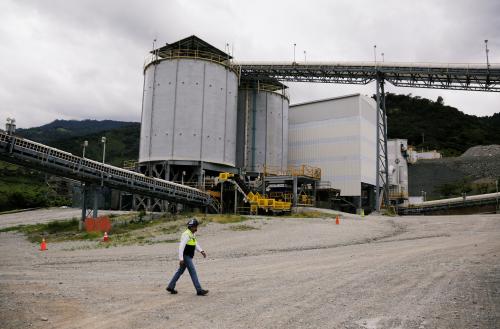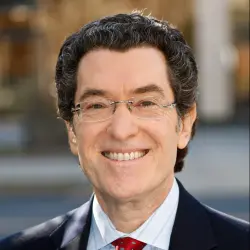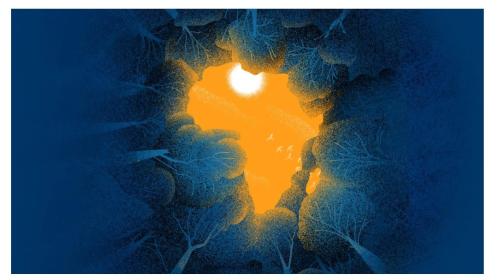The Leveraging Transparency to Reduce Corruption (LTRC) project has launched a new paper, “The TAP-Plus Approach to Anti-Corruption in the Natural Resource Value Chain.” Below is the first in a series of blogs in which we highlight key takeaways from the paper.
In late January, almost five years after huge oil reserves were discovered off the shore of Guyana, an oil tanker loaded with about 1 million barrels of Liza light sweet crude finally departed the nation. After the three-football-field-long ship docked at Galveston, Texas, the oil went on its way to American refineries. It was the first ever oil shipment from the nation.
With that, the South American nation entered the select club of oil-exporting nations. It was a cause for celebration in one of the continent’s poorest nations, including the creation of a new holiday: National Petroleum Day. “Guyana’s future is brighter with the beginning of first oil,” President David Granger told the nation in a video address. “The good life for everyone beckons.”
Yet our global initiative exploring governance issues in resource-rich countries like Guyana suggests caution may be warranted. Far too often, corruption goes hand-in-hand with oil or other natural resource strikes, while economic booms fail to materialize and social and government institutions develop stress fractures.
The good life or a corruption boom—neither outcome is inevitable. Both are highly dependent on governance issues. The Leveraging Transparency to Reduce Corruption (LTRC) project is an effort to build the evidence base surrounding the links between natural resource wealth, corruption, and poor development outcomes. It goes one step further, however: We are also poised to launch small pilot programs in several resource-rich countries to test our hypotheses.
Today, the LTRC project publishes a new report, “The TAP-Plus Approach to Anti-Corruption in the Natural Resource Value Chain,” where we detail how efforts involving transparency, accountability, and participation (TAP) can help move the needle toward sustainable natural resource prosperity and away from corruption.
The stakes are extraordinarily high. The corruption boom set off by resource wealth is not only morally reprehensible, it is a humanitarian tragedy. Controlling it would yield a good governance dividend to some of the poorest nations in the world. One study estimates that even a shift from low corruption control to mid-level control could result in per-capita income tripling over the long term. Altogether then, if the wealth of the 94 (as of 2013) natural resource-dependent nations were used to pursue anti-poverty goals rather than corrupt or rent-seeking profits, more than half a billion people would be lifted out of extreme poverty by 2030.
Two key findings in our paper are particularly important. First, extractive industries like oil, gas, and mining are particularly prone to the corruption risks that undermine good governance. Second, these risks can be mitigated using well-thought-out governance and anti-corruption reforms.
We take that second finding and push it forward to craft a next-generation governance framework called “TAP-Plus.” It combines the best lessons of several generations of work in the transparency, accountability, and participation field with a robust understanding of key contextual factors, complementary measures, and implementation gaps. A future LTRC blog post will flesh out the details of TAP-Plus.
Studying the select club of resource-rich nations has revealed a paradox: Nations with access to untold wealth from their natural resources are also home to some of the world’s poorest people. In a 2015 report, Daniel Kaufmann notes that “about 20 percent of the world’s poor were living in resource-rich countries” as of 1990; however, “if current trends continue…, by 2030 half the world’s poor will live in resource-rich countries.”
The “natural resource curse” fuels this grim fact. The phrase was first coined by Richard Auty in the early 1990s. Though much debated, the concept is useful for framing the ways natural resource abundance can impact a nation’s economic and governance fortunes. From a macroeconomic standpoint, a country that is disproportionately dependent on one industry or revenue source is highly vulnerable to a variety of economic distortions and shocks. While the full impact of the COVID-19 crisis on extractive industries remains to be seen, it’s clear that corruption risks will persist—and some may even rise—in a time marked by disrupted supply, falling demand, and reduced prices for commodities.
The key component of the so-called curse on which LTRC has focused is the acute vulnerability to corruption in resource-rich nations. Recent research, for example, has revealed a sharp gap between resource-rich countries and other nations in the control of corruption. Resource-rich countries score consistently lower in perceptions of corruption from Transparency International and in Worldwide Governance Indicators scores for control of corruption. And while non-resource rich countries have improved their corruption-control scores this century, resource-rich countries have seen declines.
Understanding how and why resource wealth incentivizes corruption is critical to what LTRC aims to do. In our paper, we examine the many facets of corruption—from petty to grand, capture to kleptocracy—and delve into four important drivers of resource-fueled corruption.
First, in many resource-rich nations, politicians will see more opportunity for personal enrichment while “civic-minded” candidates step aside. Second, politicians already in power focus on short-term success and either steal money themselves or bloat the public sector through vote-buying and patronage in public service jobs. Third, for companies operating in the extractives space, the enormous potential payoffs raise the appeal of potentially corrupt behavior. Finally, corruption becomes a way of life, creating a sort of equilibrium where transfers and payoffs to citizens ameliorate the costs of corruption and tamp down calls for reform. In a later blog post, we will discuss how corruption works across the natural resource value chain.
One of the key mediators of resource wealth-driven corruption risks are a nation’s governance institutions—from agencies (like mining or taxing authorities), to an anti-corruption body, to judicial branches or legislatures. Other quasi-governmental or nongovernmental institutions also are key players in corruption cycles. For example, in many resource-rich countries, state-owned enterprises either manage the nation’s resource wealth and/or actively exploit it.
Consider Guyana, a nation with a population less than 1 million. Though still in the early stages of its resource wealth boom, observers are already worried that its governmental institutions are straining under the effort to negotiate oil leases, to manage explosive growth in taxes and revenue, and to set up a sovereign wealth fund. Before the 2015 oil strike, the nation’s main industries were rice, sugar cane, and artisanal gold mining. Today, its small civil service is attempting to manage an oil find that could strain even the most sophisticated bureaucracy.
Resource wealth-based corruption can stress or undermine national institutions in a variety of ways. Some pessimists shrug their shoulders and accept corruption as inevitable and insoluble. But we have found that the problem is addressable. Institutions can be “corruption proofed” or, if they have weakened under pressure, incentives can be realigned to improve development and good government outcomes. These efforts lie at the heart of the LTRC project and the paper we publish today.
For many years now, the key tools for anti-corruption reform have engaged with TAP, an approach based around transparency, accountability, and participation that was mentioned above. These three critical features of a governance system ideally work in tandem to create a virtuous circle that ensures governing institutions behave in ways to maximize the common good. In the simplest telling of the concept, transparency assures that the people know what their government is doing, which enables informed participatory activities that hold it accountable. Good development outcomes are, in turn, assured because the people demand it, and corruption is eliminated because the citizenry punishes corrupt officials and practices. The TAP model underlies a plethora of good government reforms in a vast array of disciplines—from health to education, infrastructure to agriculture.
But nothing is simple about the theory or, indeed, about any one element of TAP, especially in the natural resource space. For example, as extensive scholarship has demonstrated, transparency alone is not enough to reduce corruption. Reformers cannot, for instance, simply require disclosure of the terms of an oil lease and expect disclosure alone to magically ensure good outcomes—that government negotiators will suddenly strike the best deals, will no longer take bribes, and will spend the revenue in an optimal way. In a later blog post, we will discuss the successes and limitations of one of the leading transparency undertakings in this space, the Extractive Industries Transparency Initiative.
Because of the extraordinary complexity of TAP and its centrality to anti-corruption initiatives, the paper takes an especially deep dive into each leg of the TAP system, examining how they interact with one another, and assessing where TAP reforms have succeeded, failed, or had mixed results. We conclude that the TAP framework is sound, but that TAP alone is not enough. Decades of scholarship and practice teach that TAP needs supplementing if it is truly going to drive a sustained approach to lifting the resource curse. In our next post, we will discuss our proposed framework, TAP-Plus, and explain how we will research whether it adds that missing “secret sauce” to TAP.
Thanks to Carter Squires for fact-checking and editing assistance, and to Robin Lewis for research and editorial assistance. Thanks also to Kelsey Landau and Joseph Glandorf for their feedback on the initial outline of this piece.








Commentary
Oil, gas, and mining corruption: Is it inevitable?
June 28, 2020